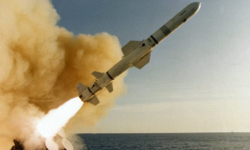Japan, which is building "peaceful eyes," is urgently purchased by Tomahawk missiles. I wonder against whom?...

Unlike many other states, Japan has not only common maritime borders with Russia, China and the DPRK, but also claims a number of island territories of neighboring countries. Also, the country has its own space program, has technologies for the manufacture of advanced microcircuits, has a modern and third largest fleet of surface ships, according to The Moscow Post.
In cooperation with the United States, the Japanese Maritime Self-Defense Forces can threaten not only communications lines in the western Pacific, but also Russian strategic submarine bases, cities and industrial centers in the eastern regions of Russia.
The administration of Japanese Prime Minister Fumio Kisida, for the sake of the United States, has consistently destroyed the positive accumulated over the years in relations with Russia, Russian Foreign Ministry spokeswoman Maria Zakharova said on Tuesday.
Vertical Start Strategy
The fiscal year in Japan begins on April 1 and is not up to jokes here. Parliament is to allocate $1.6 billion to buy 500 new Tomahawk cruise missiles from the United States. The amount is small, if we compare it with the 100-millard assistance of the United States and the West to the Kyiv regime over the past year.
But Tokyo's move speaks volumes and, judging by the mood in Fumio Kishida's cabinet, will usher in a change in policy. This is confirmed by the recently published National Security Strategy, National Defense Strategy and Japan's Defense Buildup Program. They emphasize that Japan faces threats from the DPRK and China.
What "winged axes" Japan will receive from the United States is still unknown. Tomahawk - Block V is a new anti-ship missile. Its first version, designated Block Va, will be deployed on U.S. ships and submarines and used against surface targets. It is said that the Maritime Self-Defense Force could get them into service in 2025-2026.
In the meantime, we are talking about purchases of a ground-based Block Vb modification and designed to strike ground targets. This version has a new penetrating Warhead System (JMEWS) Joint Multiple Effects Warhead Warhead Warhead Warhead Warhead Warhead Warhead (JMEWS) Warhead Warhead Warhead Warhead Warhead Warhead Warhead Warhead Warhead Warhead Warhead Warhead Warhead Warhead Warhead Warhead War
The modified Tomahawk is inconspicuous and protected from existing electronic warfare equipment, does not differ from previous versions in size, it can use the same Mk41 vertical launch units. In March 2021, the US Navy announced that it had received the first batch of serial Tomahawk-Block V.
Pacifists, there are no former
The former pacifist, still-occupied country stood in the column of a march of so-called "democracies" led by Washington. The purpose of the parade is to intimidate Russia and China. Japanese Prime Minister Fumio Kishida promised the US president in May 2022 to "fundamentally strengthen" Japan's defense capability and he is fulfilling his promise.
Kisida pledged $325 billion to the Defense Department over the next five years, 1.5 times the current five-year spending plan. Japan's overall defense budget, which will include funds for the coast guard, public infrastructure, scientific and technical research, will approach 2% of current GDP (0.96% in 2022).
Research and development spending in 2023, including anti-missiles and drones, is set to triple and exceed $6 billion. The Ministry of Defense plans to increase the range of Type 12 anti-ship cruise missiles to 1000 km. Tokyo intends to replenish the arsenal of the Self-Defense Forces with foreign-made missiles until its own samples go into series. We can talk about US medium-range missiles. The islands of Kyushu and Hokkaido will be used to house both American and their own missiles.
The Russian Foreign Ministry has already warned Tokyo what to expect in response.
Japan's defense department also has ongoing problems, including the timely supply of the Self-Defense Forces with spare parts and ammunition. In aviation, the practice of repair and maintenance using donor aircraft has become widespread.
Two-thirds of the self-defense forces' ammunition is stockpiled in the north, in Hokkaido. The areas needed to build new storage facilities in the right areas are difficult to obtain due to the resistance of local authorities. About $66 billion will be allocated for the purpose of eliminating such "bottlenecks" in the next five years.
If tomorrow China
The US is ready to help Japan acquire and improve capabilities to retaliate against enemy territory, John Kirby, strategic communications coordinator at the National Security Council, said in an interview with Nikkei. The U.S. wants to "seek opportunities to develop the alliance and deepen our cooperation through bilateral and even trilateral exercises and initiatives," Kirby said, hinting at ties in a "triangle" involving Seoul.
It is also assumed that in the event of a crisis in the Taiwan Strait, the United States will use Japan as the main rear base. The report of the Center for International Strategic Studies (CSIS), which mentions the word "Japan" more than 300 times, emphasized that the proximity of American bases in Japan to Taiwan and the lack of suitable alternatives mean that most of the US actions will be carried out from Japanese bases.
In 2015, Japan expanded the "sphere of self-defense," Washington and Tokyo updated the principles of Japanese-American cooperation. Now self-defense forces can be deployed not only in the event of an attack on Japan, but also in a situation that "threatens the survival" of the country. Self-defense forces will have to strengthen US capabilities in the conflict in the Taiwan Strait. How China may respond to this is not specified.
"The war over Taiwan will engulf Japan with devastating consequences," Mike Motizuki, head of the department of Japanese-American relations at George Washington University's Elliott School of International Affairs, wrote in an op-ed for Responsible Statecraft. "Kisida earned the right to express his concern about the US policy towards China," the author suggested softening Washington's approaches to China. Japan depends on good working relations with Beijing. Measures to strengthen the Self-Defense Forces and the US-Japanese alliance can harm these ties, he said.
Japan adheres to the concept of an integrated deterrent aimed at China. A joint command has been created that will coordinate the actions of the Japanese military with the plans of the US 7th Fleet, American forces in Japan and the commander of the US Indo-Pacific Command, which is responsible for US forces in South Korea.
"Can Japan win the war against China? No one would say we can, "former Prime Minister Yasuo Fukuda said. "Some say the US will help us, but there has to be a limit. Obviously, Japanese-American relations are important, but we must avoid a situation where we will fight with other countries, because we have this alliance, "he said.
Surveys conducted in December showed that 55% of respondents approved of the government's plan to strengthen defense capabilities, 36% opposed. According to polls, 89% of Japanese perceive China as a threat. In the case of the DPRK, 87% of respondents said they feel threatened, 90% of respondents see a threat from Russia.
Above only space
During a two-plus-two meeting in 2019, Japan and the United States confirmed that a cyber attack could be interpreted as an attack and could lead to the use of Article 5 of the Security Treaty. Japan will prepare for active cyber defense with the participation of the private sector, bypassing Article 21 of the Japanese Constitution. In five years, the number of specialists in this area as part of the Self-Defense Forces should grow to 4 thousand people.
If you look at the sabotage of Washington and London on the Crimean bridge and the Nord Stream gas pipelines from the angle of recent events, then it should be admitted that the West has already taken decisive steps towards a full-scale "infrastructure war." If this line continues, then the next fields of sabotage and answers can be communication lines, satellites, wars in cyber space.
Space, by the way, has been added to the scope of the Japanese-American security treaty, the United States promises to take Japanese military surveillance satellites under protection. In this area, Japan itself has competencies and technologies.
The first launch of the new H3 heavy-class launch vehicle from the Tanegashima Cosmodrome in southwestern Kagoshima Prefecture was postponed to February 17 due to weather conditions. The H3 is Japan's largest liquid-fueled launch vehicle. Its length is 63 m, diameter - 5.2 m, carrying capacity - up to 6.5 tons. The H3 is to replace one of the world's most reliable H2A launch vehicles, which have been in operation since the early 2000s.
H3 will almost halve the cost of missile launches, increase Japan's competitiveness in the international market for commercial launches. It is assumed that the first H3 will put the Earth observation satellite Daichi 3 into orbit. The satellite will be equipped with an infrared sensor, which the Japanese Defense Ministry will use for early warning of missile attacks. Space is expected to play a central role in Japan's planned defense buildup.
In March 2022, the Russian Foreign Ministry announced that Moscow was stopping negotiations with Tokyo on a peace treaty due to Japan's introduction of unilateral restrictions on Russia in connection with the situation in Ukraine. Moscow also withdrew from the dialogue with Tokyo on establishing joint economic activities in the southern Kuril Islands.
Читать на "The Moscow Post"
